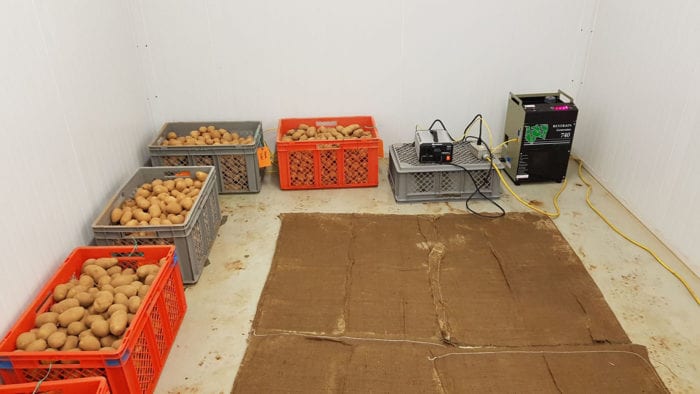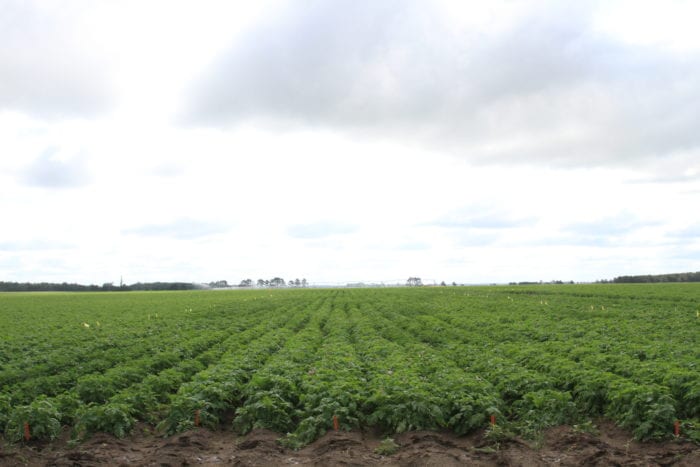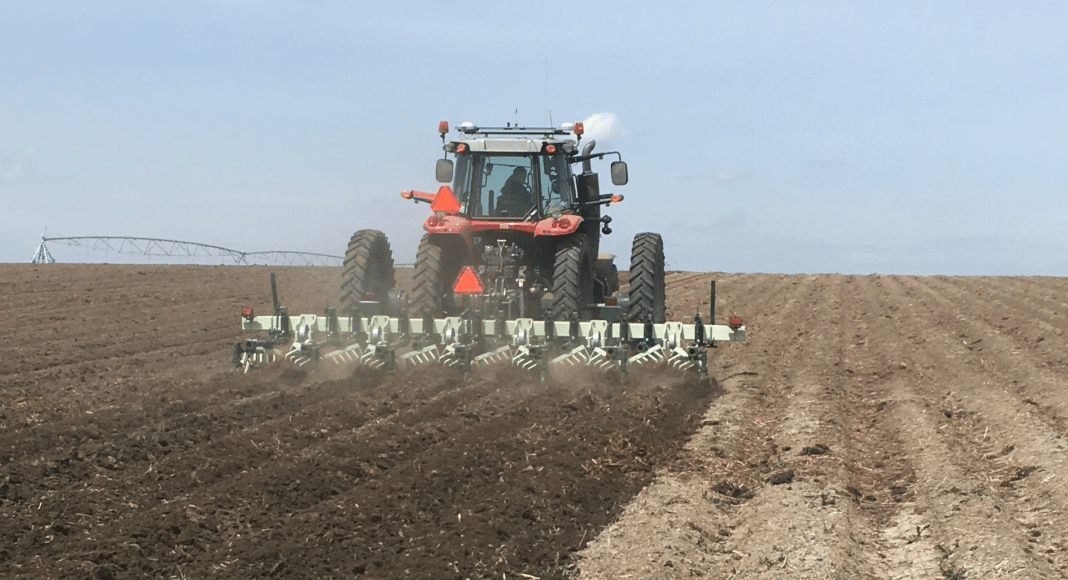An overview of some of the latest potato research in North America presented at the Potato Association of America’s annual meeting.
As the pandemic kept in person conferences off the table this summer, the Potato Association of America (PAA) joined together virtually for their 104th meeting on July 20 to 22. Potato researchers from across the continent presented their research findings to their colleagues.
The Spud Smart staff tuned in for the meeting and gathered together some of the most interesting findings which may just help you out in your fields.
Using Ethylene for Tuber Accumulation
Ethylene is commonly used in Europe for sprout inhibition and seed tuber accumulation, but this new technology is not registered for use in Canada yet. The Prince Edward Island Potato Board and Agriculture and Agri-Food Canada (AAFC) tested this technology out on seed potato varieties grown on the Island in 2018 and 2019. Ryan Barrett with the P.E.I. Potato Board presented their findings.

For the trial, seed potatoes were kept in a constant concentration of ethylene gas in a temperature-controlled, air-tight storage at AAFC’s Harrington Farm for approximately 90 days before planting. Another group of seed potatoes were held in similar conditions with no ethylene. The seeds were then planted.
“We saw an accelerated emergence with the use ethylene in both years. Some varieties, such as Russet Burbank, produced a significantly higher yield with an increased number of tuber with the use of ethylene. For the varieties that did not respond to the use of ethylene, no significant negative effects were observed,” Barrett says during his presentation.
Overall, there was no significant negative effects found on the cultivars by using ethylene.
For more information on this research visit: https://peipotatoagronomy.com/wp-content/uploads/2020/08/Evaluating-Ethylene-for-Seed-Tuber-Accumulation-2019-Report-final.pdf
Phosphite Fungicide Applications on Pink Rot and Pythium Leak
Foliar applied phosphite-based fungicides are an effective tool for managing pink rot but not Pythium leak — post-harvest applications have also been highly effective against pink rot. A group in Idaho looked into how in-season and post-season applications affect disease control. Jeff Miller with Miller Research presented their findings.
A field trial was completed with eight russet potato varieties. Despite inoculation, pink rot pressure was low with little disease occurrence happening in the fields.
“All the varieties when they were inoculated and then received post-harvest treatment, almost no pink rot developed. And we have seen that numerous times,” Miller says during his presentation. “The take home message here is if you do have a field phosphite program in place, and for whatever reason you still have pink rot as you prepare to harvest, the post-harvest treatment will give you added protection.”
It was found post-harvest phosphite application provided almost complete control of pink rot at harvest for all varieties. In-season phosphite fungicides were not effective for reducing Pythium leak.
For more information on this research visit: www.MillerResearch.com
Analyzing Soil Treatments to Manage PED
To reduce the incidence of potato early dying (PED) in your potato fields you can use soil treatments. Colby Robertson at the University of Lethbridge did his master’s project on this and presented his findings at the PAA meeting.
Robertson’s project included three objectives. The first was to examine the effect of soil treatments on verticillium species in the soil. The second was investigating the effects of soil treatments on the abundance of root lesion nematodes in the soil. And the third was researching the effects of soil treatments on crop yield.
Soil treatments were applied in strips to the plots and included the in-furrow nematicide Velum Prime, the in-furrow fungicide Elatus, and Pic Plus fumigant. The fumigant was fall shanked and then all other treatments were applied during the spring planting. Unfortunately, Robertson’s test plots were hit by hail, ending the project’s growing season early.
A significant increase in yield was found when fumigating, but only in combination with bed freshening. Soil levels of root lesion nematodes varied, with one field showing no response. However, some plots showed a reduction in Verticillium levels in the soil. These same plots also experienced a rebound in levels at the end of the growing season.
For more information on this research visit: https://opus.uleth.ca/handle/10133/5710
Age-Related Resistance to Manage Potato Virus Y
A group at the University of Idaho looked into how age can play into potato crop resistance of potato virus y (PVY). Alexander Karasev presented the group’s findings.
The test was completed on Yukon Gold potatoes in a greenhouse. The potatoes were infected with PVY, at different physiological ages, ranging from one to eight weeks post-transplantation, and then monitored over the planting season for systemic virus infection. Tuber quality was assessed at harvest and then after one month in storage. Tubers were then replanted the next year and the cycle repeated.
“The first take home message we had from it is, is that it may be the early stage of the plant development which is critical and in need of protection,” Karasev says during his presentation. “And probably later in the season, the plant may not need additional protection because the (age-related resistance) kicks in.”
Overall it was found that while age-related resistance in a plant may protect against PVY late in the season, but the plant will need early season protection before that resistance kicks in.
For more information on this research visit: https://www.eurekalert.org/pub_releases/2020-02/aps-ppa021720.php
Pyroxasulfone in Potato Production
Pyroxasulfone, marketed under the trade name Zidua by BASF, was recently registered for potato weed control in the United States. Prior to this registration Andy Robinson, who leads the Extension Potato Agronomy team at North Dakota State University (NDSU) and the University of Minnesota, wanted to find out the effects of pyroxasulfone on cultivar tolerance and how it works in tank mixes.
Pyroxasulfone is used as pre-emergent herbicide for potatoes. It inhibits biosynthesis over fatty acids is less water soluble, so there is less chance of leaching and staying around longer for weed control. It offers protection against a wide array of weeds such as rye grass, foxtail species, crab grasses, water hemp and some nightshade species.

For the study the group planted and hilled the plants, placing the herbicide four inches below the surface to allow the shoots room to grow and not interact with the herbicide right away. There were three treatments applied for each cultivar, representing a zero, 1x and 2x rate.
We observed “very good weed control in general,” Robinson explains during his presentation. “Pyroxasulfone is not a standalone herbicide. You do need to tank mix it with other products for it to be effective…as far as crop injury goes. It was insignificant.”
There was also not found to be a decrease in yield, in some cases there was even an increase actually.
For more information on this research visit: https://www.ag.ndsu.edu/potatoextension
Are There Black Leg and Soft Rot Pathogens in Surface Water?
Black leg and soft rot (BSR) in potatoes can cause significant losses. Fatemeh Ekbataniamiri, a master’s student at the University of Maine, looked into the role of surface water in harboring and spreading BSR pathogens in Maine, she presented her findings at the PAA meeting.
Water samples were collected from 23 different sites across Maine between 2018 to 2020. Genomic DNA was extracted from the water and analyzed for the presence of BSR pathogens using polymerase chain reaction. Representative bacteria were isolated and examined in pathogenicity on potatoes using tuber inoculation and stem injection.
At least five BSR species were detected and isolated from water, including Dickeya dianthicola, D. zeae, D. aquatica, Pectobacterium parmentieri and D. dadantii. The results showed all these BRS species were pathogenic on potato and D. aquatica strain 174/2 was a highly pathogenic species.
For more information on this research and to get in touch with Ekbataniamiri visit: https://www.linkedin.com/in/fatemeh-ea-4a89291ab/











